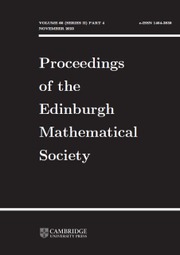No CrossRef data available.
Article contents
Can you tell a tree from its branches?
Published online by Cambridge University Press: 15 September 2025
Abstract
For each set X, an X-split is a partition of X into two parts. For each X-split S and each subset  $Y\subseteq X$, the restriction of S on Y is the Y-split whose parts are obtained by intersecting the parts of S with Y. For a graph G with vertex set V, the G-coboundary size of a V-split S is the number of edges in G having non-empty intersections with both parts of S. Let T be a tree without degree-two vertices, and let V and L denote its vertex set and leaf set, respectively. For each positive integer k, a k-split on T is an L-split that is the restriction of a V-split with T-coboundary size k, while a score-k split on T is a k-split on T that is not any k′-split for any integer
$Y\subseteq X$, the restriction of S on Y is the Y-split whose parts are obtained by intersecting the parts of S with Y. For a graph G with vertex set V, the G-coboundary size of a V-split S is the number of edges in G having non-empty intersections with both parts of S. Let T be a tree without degree-two vertices, and let V and L denote its vertex set and leaf set, respectively. For each positive integer k, a k-split on T is an L-split that is the restriction of a V-split with T-coboundary size k, while a score-k split on T is a k-split on T that is not any k′-split for any integer  $k' \lt k$. Buneman’s split equivalence theorem states that the tree T is entirely encoded by its system of score-1 splits. We identify the unique exceptional case in which the tree T is not determined by its score-2 split system. To explore how our work can be extended to more general tree isomorphism problems, we propose several conjectures and open problems related to set systems and generalized Buneman graphs.
$k' \lt k$. Buneman’s split equivalence theorem states that the tree T is entirely encoded by its system of score-1 splits. We identify the unique exceptional case in which the tree T is not determined by its score-2 split system. To explore how our work can be extended to more general tree isomorphism problems, we propose several conjectures and open problems related to set systems and generalized Buneman graphs.
MSC classification
Information
- Type
- Research Article
- Information
- Copyright
- © The Author(s), 2025. Published by Cambridge University Press on behalf of The Edinburgh Mathematical Society.
References
 $2 kn-\binom{2k+1}{2}$: A note on extremal combinatorics of cyclic split systems, Sém. Lothar. Combin. 47 (2001), B47, pp. 17. https://eudml.org/doc/121892.Google Scholar
$2 kn-\binom{2k+1}{2}$: A note on extremal combinatorics of cyclic split systems, Sém. Lothar. Combin. 47 (2001), B47, pp. 17. https://eudml.org/doc/121892.Google Scholar

